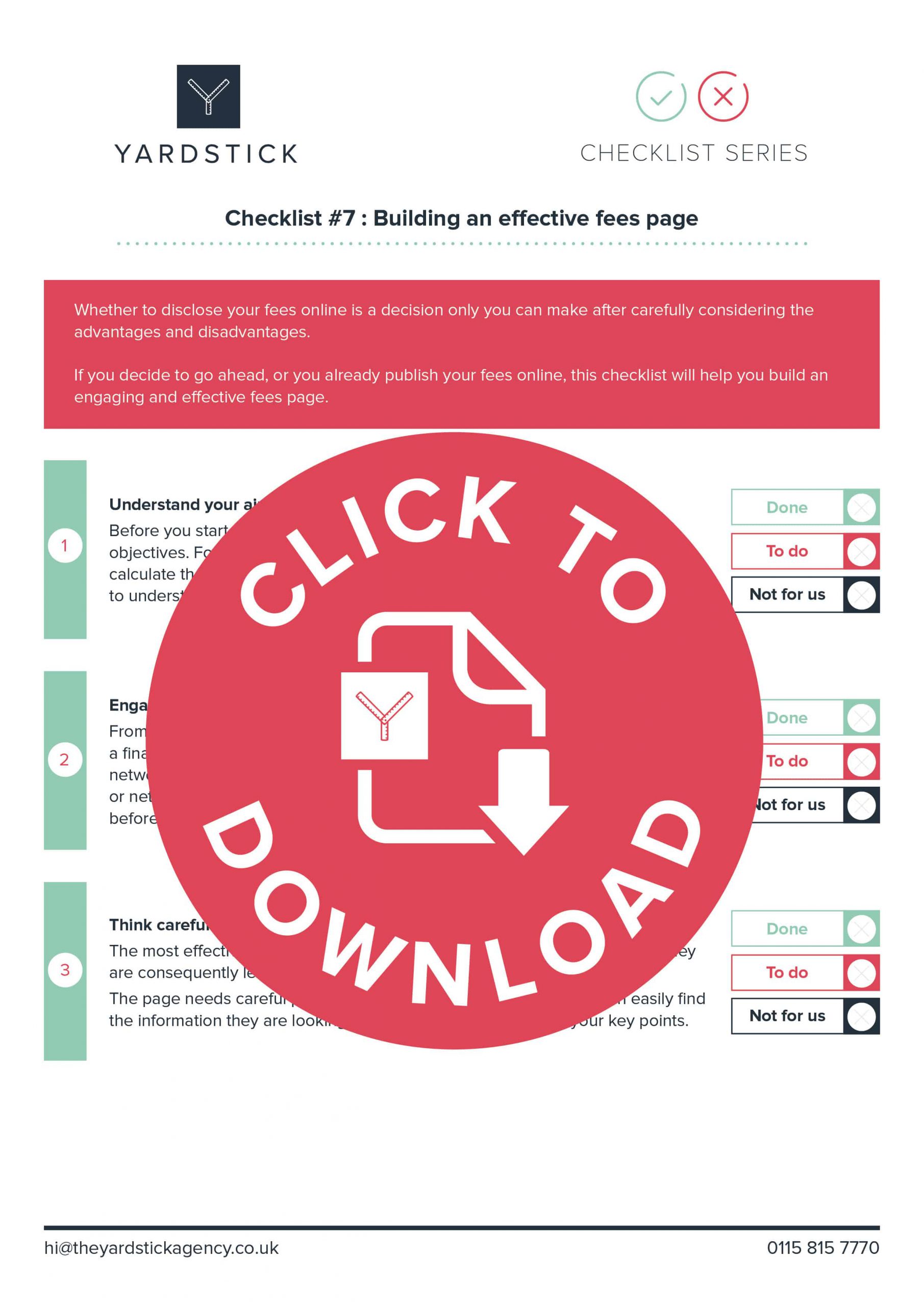 Whether or not to disclose your fees online through building an effective fees page is a decision only you can make after carefully considering the advantages and disadvantages.
Whether or not to disclose your fees online through building an effective fees page is a decision only you can make after carefully considering the advantages and disadvantages.
If you decide to go ahead, or you already publish your fees online, this checklist will help you with building an effective fees page.
1. Understand your aims
Before you start developing your fees page it’s vital you understand your objectives. For example, do you want the potential client to be able to calculate the exact cost of engaging with you, or do you simply want them to understand certain principles?
2. Engage with compliance
From a regulatory perspective, your website will no doubt be deemed to be a financial promotion. Consequently, it will need checking and, if you are part of a network, approving. We recommend engaging with your compliance support or network at an early stage, so you understand their specific requirements before you start the writing and development process.
3. Think carefully about how the page is written and designed
The most effective fees pages contain a significant amount of information. So, they are often lengthy.
The page needs careful planning and design to ensure that you can make your key points and that your visitor can easily find the information they are looking for.
4. Your website’s navigation
Our research shows that the websites which had the highest engagement on their fees pages were those where it was easy to find.
Consequently, we recommend including it in the main navigation.
5. Explain why online fee disclosure differentiates you
The clear majority of advisers and planners don’t disclose their fees online. By building an effective fees page you will stand out. We recommend explaining why you have taken the decision to include your fees on your website, how it benefits the reader, and that it sets you apart from your peers.
Furthermore, you should carefully explain anything about how you charge which differentiates you from other advisers and planners. For example, if you charge fixed rather than ad valorem fees at every stage of the planning process, explain why you do this, how it differentiates you and, most importantly, how it benefits your clients.
6. Explain fees alongside your services
Too many advisers and planners simply explain their fees without demonstrating the value they add, or even explaining what the client receives in return. We recommend laying out your fees and services alongside each other for each stage of your process, including:
- Initial meeting; usually free (take care to explain this)
- Preparation of a financial plan
- Implementation
- Ongoing planning/advice
If you offer a ‘planning-only’ service, without the requirement to take ongoing advice, this should be made clear too.
7. Be specific
If your aim is to help clients understand what you charge, it isn’t particularly helpful to give extremely broad ranges.
Be as specific as you can, so the potential client can understand what they will pay and the value they will receive in return.
8. Mention hourly rates
If you offer clients the option of paying an hourly rate for your services explain that on the page.
However, the average consumer will probably struggle to understand how long a piece of work might take and therefore won’t be able to calculate the fee. Include examples of the occasions when you might work on an hourly rate basis, as well as the likely cost, as this will help overcome this problem.
9. Make your VAT position clear
Explain whether VAT is chargeable. This might save awkward conversations at a later date if your client discovers their bill is 20% higher than they anticipated.
10. Give examples
Irrespective of whether you offer an hourly rate option we recommend including short examples of typical client scenarios explaining your fees for the services received.
Doing so will bring your fees to life and help potential clients understand what they might pay based on people in a similar situation to them.
11. Consider a calculator
Including a calculator on your fees page will help website visitors understand the exact fees they will pay.
The more complex your fee structure, the more beneficial a calculator is to the consumer. They are surprisingly easy to build, too.
12. A comparison of fees
Consider adding a comparison to show how your fees compare to your peers.
This can be particularly powerful for advisers and planners who charge fixed fees or hourly rates and work with wealthier clients.
The FCA’s Data Bulletin from October 2016 is particularly useful here. Email hi@theyardstickagency.co.uk if you would like a copy.
13. Demonstrate value
Too many advisers and planners disclose fees in isolation without explaining the services clients receive in return, or the value they add. We recommend including:
- Independent research to demonstrate the value of advice. The research from the International Longevity Centre – UK (ILC-UK), supported by Royal London and Vanguard’s Adviser Alpha, is particularly useful here.
- Information about the intangible benefits of working with you
- Client testimonials
14. Request feedback
Your fees page is likely to be relatively long and potentially complex.
Once it has been developed we recommend ‘road testing’ it. Ideally, test it with people who are in your target audience but aren’t existing clients (as they will naturally understand your fees already).
The aim is to understand whether you achieved your initial objective. Gauge their understanding of fees/services having reviewed the page.
Remember, you are looking for trends. Making changes based on single opinions can be dangerous.
We hope this helps
Building an effective fees page to disclose your fees presents a different set of challenges to other parts of your website.
The page is likely to be long and potentially complex. Furthermore, get it wrong and you might deter some people from getting in touch. That means the stakes are high and extra care needs to be taken in the layout, design, and text.
We hope you found this checklist useful. If you have questions or would like to know more about our website design services, please don’t hesitate to get in touch.




